
The Ferrari Challenge |
|||
The Establishment The Conditions The Support |
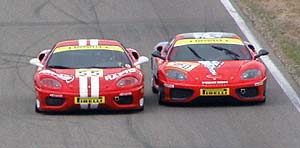 |
||
The Establishment
In 1993 for the first time in the firm history a mark cup was founded: the Ferrari Challenge. For many owners it was a dream running with a Ferrari on track. Now, under patronage of the Scuderia the Challenge should offer the possibility of letting this dream come true. Similar vehicles and therefor fights on highest sporty level should continual mark the Ferrari Challenge. In the first year a European and a seperate Italian series were held, already in the second year the American Challenge was added. Furthermore the European series had to be devided into two series according to the high demand. In 1995 the Japanese Challenge has been added, followed by the Pacific Series in 1996. At the end of each season the participants from all series come to final at Mugello or Pergusa, the highlight of the year.
The conditions for permission in this running series are attested possession of a Ferrari as well as a close contact between driver and dealer, due to the fact that the registration into the running series can only be effected by the dealer. Many participants of the Challenge hade made experiences already before entering the challenge, therefor there are hard fights even though the cars are very valuable.
Because of the high costs, typical for all running series, partners had to be found. Already at the beginning of the Challenge in 1993 Ferrari had found 3 energetic partners. Pirelli provided drivers and opperating authorities with tires and service free of charge, now they take a low flat rate. The rims were first supplied by speedline since the year 2000 for free charge. With the introduction of the 360 Challenge BBS took over this service. Agip provided fuel and lubricant up to the discharge of the contract, afterwards Shell took over this service for all participants free of charge.
| |||||||||||||||||||||||||
The Cars |
|||||||||||||||||||||||||
|
The first Challenge races were driven with the Ferrari 348TB, which however did no more correspond to 100 per cent to the regular series vehicle. Each Ferrari is designed for a sporty way of driving, but in race the requirements to the vehicle are harder. Therefore some changes for the F 348TB were developed in autumn 1992 before the beginning of the Challenge, which should not influence the road permission. A large part of the changes referred to the safety equipment of the vehicle.
 A safety cage, for-point seat-belts, a fire extinguisher, a hitch as well as an external circuit breaker were installed. The changes always had to be made with original spare parts, which Ferrari placed for disposal. From this program also another transmission translation as well as a changed oh geometry and special pedals and challengeseats could be selected. A great taboo was the modification of the engine as well as the turn off of the catalyst, whereas some functions such as the air conditioning system or ABS could be turned off. The race-ready Ferrari had to weigh 1360 kg. In autumn 1993 the modified 348 was presented, the 348GTB. It had e.g. 20 hp more. The 'old' 348 were re-tooled with an engine kit not to be disadvantaged. | |||||||||||||||||||||||||
|
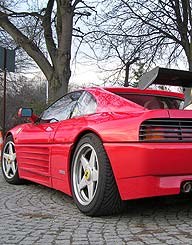 |
||||||||||||||||||||||||
In summer 1994 the F 355 was presented, in autumn of the same year also the challengeversion was presented. The 355 Challenge now already exhibited factorymade points of mounting plate for the cage, as well as lighter bumpers. The essential extras like the cage as well as belts, fire extinguishers and hitch etc. however still had to be re-tooled. In order to guarantee equal chances, the engine as well as the absorbers were plombed, since it had come to some offences against these rules (engine & modification of the suspension were taboo) in the first years. Another important innovation to the 355 Challenge were the large brakes by Brembo, which became standard and substantially steadfaster than standard equipment (it was already used in 348 competizione). However this innovation involved a further change: Larger rims had to be used, now with 18". A new sport exhaust system became standard. However it was no longer possible to use this cars on official street. At the end of 1995 the 348 was banished from the European series and one year later from the others.
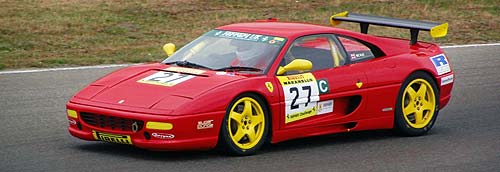 Until 1997 there were only few changes, then however the tail spoiler for the 355 Challenge was introduced. It should improve the road-hugging property of the 355 extremely. The Challenge imported in 1998 (also named Evoluzione) was already race-ready by leaving factory and could no more be converted into road car later. From now on it was not possible to reequip the series vehicles into a challengecar, too. The innovations in the Evoluzione were from large extent. It is recognizable from missing headlights, whereby 15kg were saved. The security concept was revised, a strengthened cage with side impact protection and an automatic fire-extinguishing system (to activate also from the instrument panel by pushing a button) were the result. A further technical improvement was a large oil cooler at the left front apron to preserve the gearbox during the race. The oil water heat exchanger in the V between the two cilynderrows of the 3,5-Liter with 8 cilynders was replaced by a connecting tube. A t-bit in the exhaust system functioned like a kind relief valve, which steered the exhaust gases past the waste gas catalysts at numbers of revolutions over 3500/min directly into the final muffler. Ex-Ferrari-F1-testdriver and Alfa STW pilot Nicola Larini, who looked after the fine tuning of the "Evoluzione", reached thereby in Mugello nearly one and a half seconds faster round times than in the 97er 355 Challenge. |
|||||||||||||||||||||||||
|
 |
||||||||||||||||||||||||
In July 1999 the 360 Challenge was presented by Michael Schumacher during the Racingdays on the Nuerburgring. It was directly produced for races and thus substantially more unkompromising than the previous challengecars. It is used since the beginning of the season 2000. 1170kg and thus 150kg less than the 355 Challenge the new Challengecar weights. This as a result of the new spaceframe technology, a complete aluminum structure, which is very light and additionally increased the rigidity. Less weight was reached by a radical moved out cockpit, plexiglass windows and renunciation of all unnecessary additional aggregates. Moreover the accessories needed for running employment, a Brembo racebreak under 18"BBS light alloy wheels, a highspeed tank system with safety tank, an automatic fire-extinguishing system and a single racing seat in the safety cage were installed.
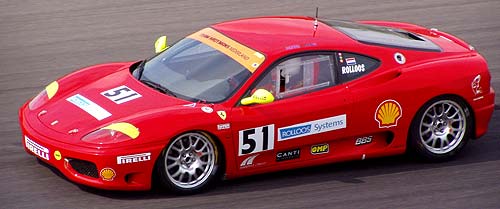 In the cockpit a digital instrument panel is integrated, in order to faciliate interactive data query e.g. for the telemetry. The new sequential, electrohydraulic-F1-shifter is equipped with active wheel suspensions and "fly by wire"- accelerator pedal. The aerodynamic style from by Pininfarina brings around a disguised bottom and a diffuser at the rear, whereby enough contact pressure is reached that a tail wing is superfluous. With the beginning of the new season 2003, the following changes become effective: The races are no longer devided into two classes (gentlemen or experts). Now there are two different races, devided into Ferrari Challenge Trofeo Shell (beginner) and Ferrari Challenge Trofeo Pirelli (experts). |
|||||||||||||||||||||||||
|
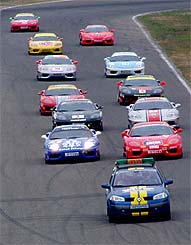 |
||||||||||||||||||||||||